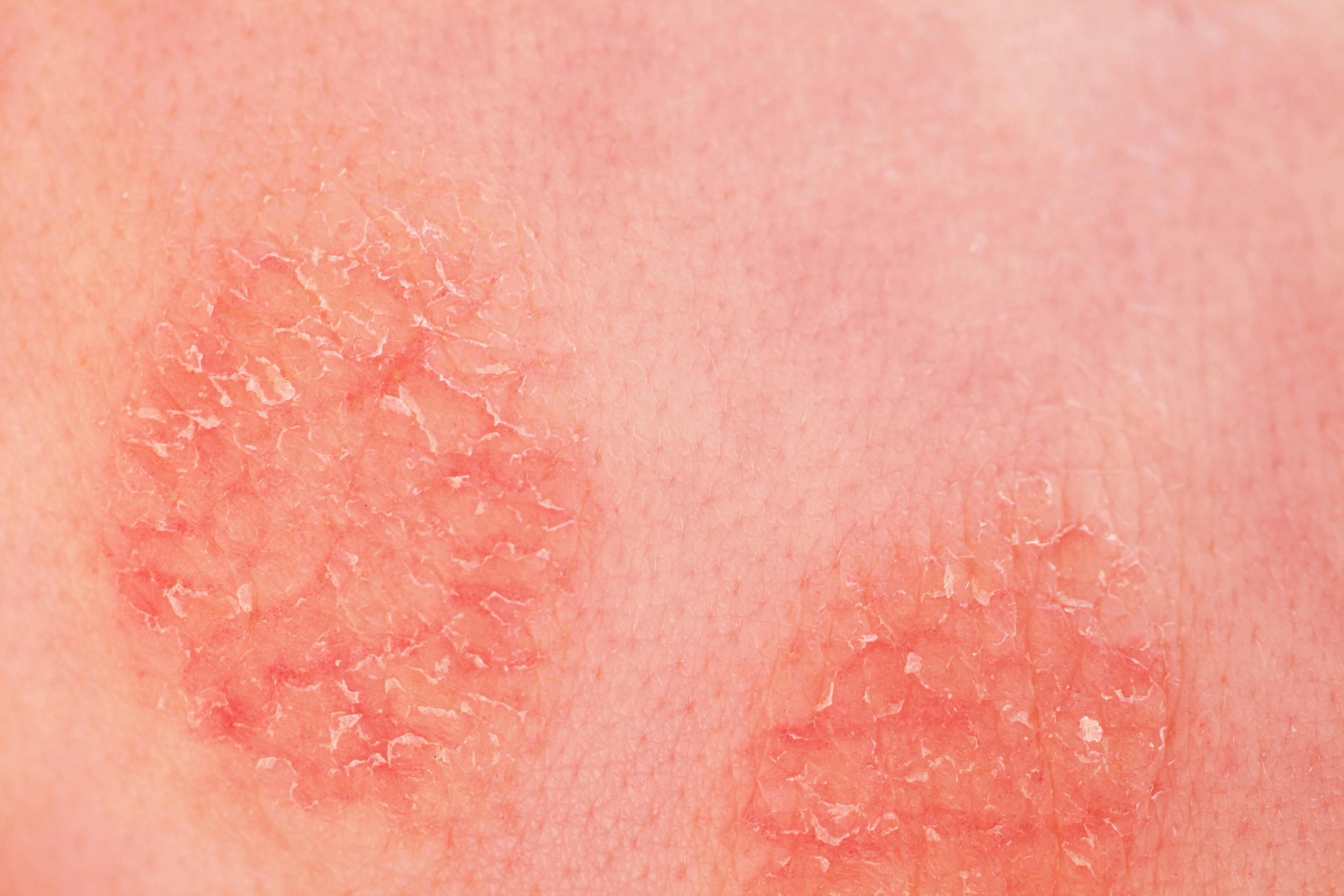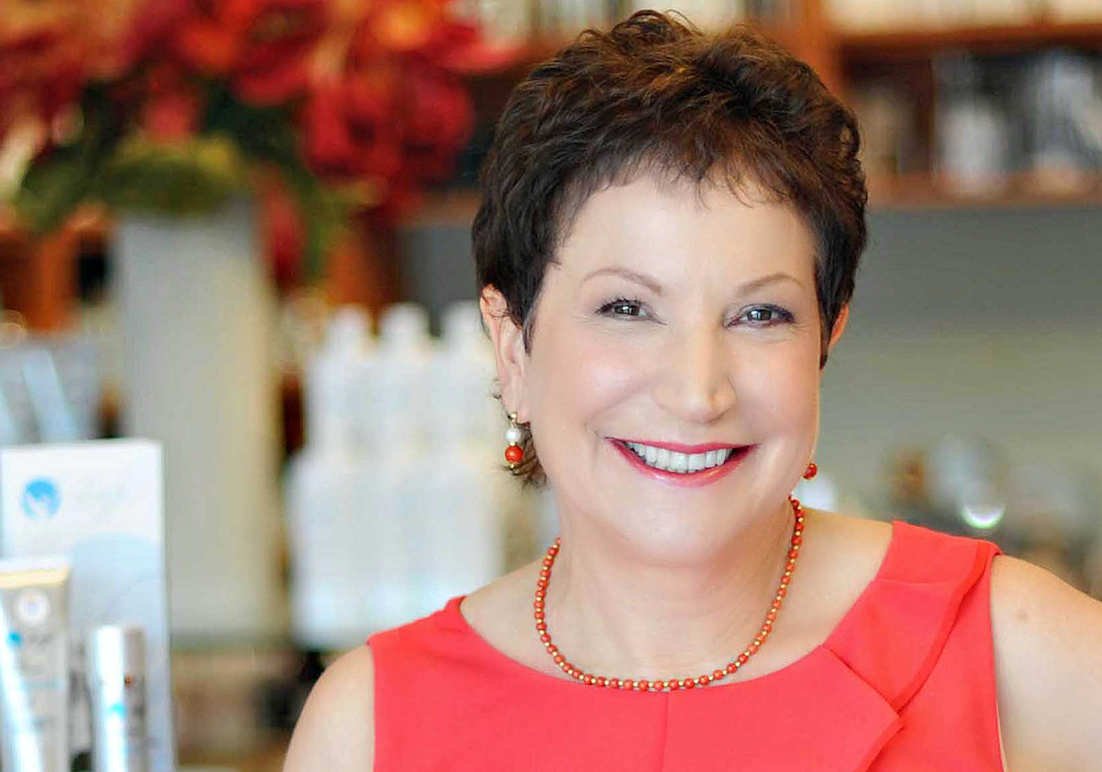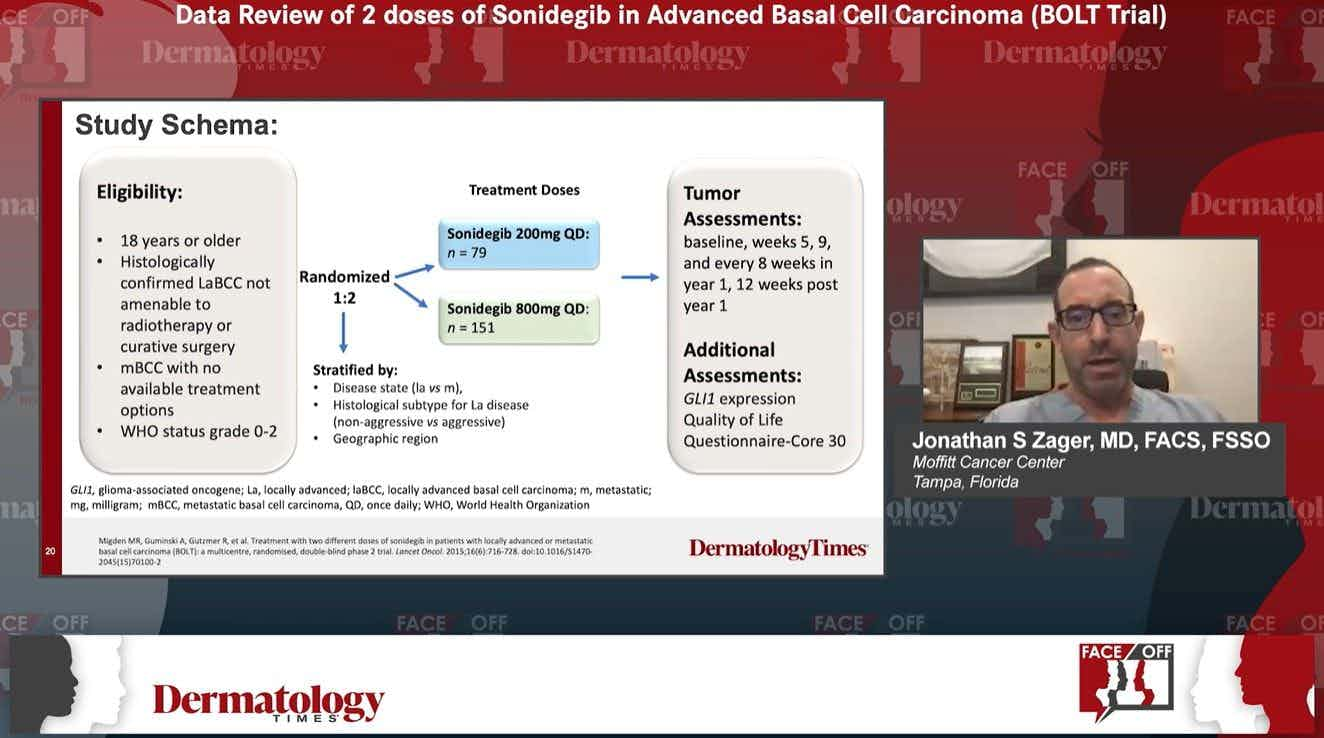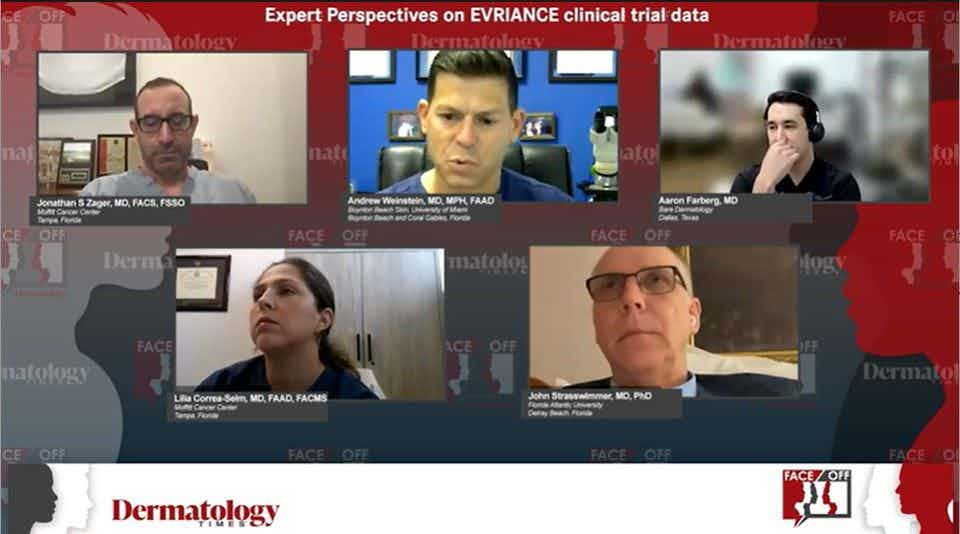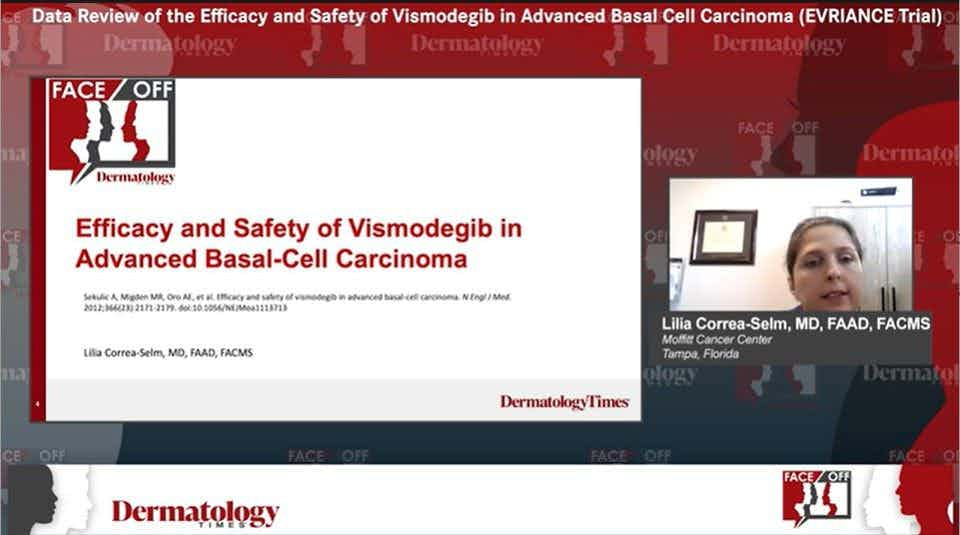- Acne
- Actinic Keratosis
- Aesthetics
- Alopecia
- Atopic Dermatitis
- Buy-and-Bill
- COVID-19
- Case-Based Roundtable
- Chronic Hand Eczema
- Chronic Spontaneous Urticaria
- Drug Watch
- Eczema
- General Dermatology
- Hidradenitis Suppurativa
- Melasma
- NP and PA
- Pediatric Dermatology
- Pigmentary Disorders
- Practice Management
- Precision Medicine and Biologics
- Prurigo Nodularis
- Psoriasis
- Psoriatic Arthritis
- Rare Disease
- Rosacea
- Skin Cancer
- Vitiligo
- Wound Care
Publication
Article
Dermatology Times
Treatments Updates for BCC, SCC
Author(s):
BCC, SCC treatments take advantage of refinements in established techniques and new technology.
Advances in preventing, diagnosing, and treating basal cell carcinoma (BCC) and squamous cell carcinoma (SCC) come from increased knowledge and debate around how best to use proven techniques and new technologies and medications. But current innovations in treating BCC are not necessarily bold-faced change, said Suzanne Olbricht, MD, FAAD, dermatologist-in-chief at Beth Israel Deaconess Medical Center and associate professor of dermatology at Harvard Medical School in Boston, Massachusetts, in a presentation at the Skin Cancer Symposium 2021.1
Instead, margin debates for excision and the ability to use a large armamentarium of treatment options allow dermatologists and dermatological surgeons to offer increasingly personalized care. For SCC, gene expression profiling test helps remedy the shortcomings of staging models, and some newer drugs offer strong results.
Basal cell carcinoma
The list of known risk factors for BCC has grown, Olbricht said. Tanning bed use is a well-known risk factor, for example. But antihypertensive use has been linked to BCC in numerous studies, and citrus consumption and chronic stress also are risk factors. Occupational risks include being a pilot, arc welder, or interventional cardiologist, however, Olbricht didn’t detail the reasons for the increased risk, she did point out that both patients and dermatologists need to be more aware of occupational sun exposure, not just leisure sun exposure. Conversely, vitamin D3 in skin and caffeine consumption are associated with decreased risk of BCC.
Moving from prevention to treatment, Olbricht discussed the debate around margins in treating BCC with Mohs surgery or similar techniques. She favors 4-mm margins, citing a much lower risk of recurrence when compared with results from excisions with 2-mm margins, as shown in results of a 2020 study.2 She added that in her practice most patients prefer a slightly longer scar to the risk of a second procedure.
In her second presentation,3 Olbricht gave an overview of the nonsurgical options available to treat BCC. “For each cancer and each patient, all options are worth considering,” she said. “Basically, what I think is that if you have a small, well-demarcated lesion on the trunk… almost anything is going to treat it well, so you have an opportunity to explore a number of treatment options with the patient. As far as the literature goes, the best studies have [5]-year follow-up, but those are few in number, and you probably can get a pretty good idea by [3]-year follow-up.”
With such a large toolkit to choose from, patient health, lifestyle, and preferences can vary widely. Olbricht cited examples from her practice where 3 patients with small BCCs chose 3 different options for treatment: electrodessication and curettage, topical imiquimod, and Mohs surgery. All were satisfied with their treatment.
Olbricht stressed the importance of extending this kind of individualized treatment in consultation to all patient populations. For older patients, in particular, it is vital for the medical team to consider the individual and not simply the demographic they occupy. Olbricht chooses observation or minimal treatment more often for this patient population, but once she decides to treat the toolkit is the same as for younger patients. Mohs does not constitute a quality-of-life concern for elderly patients.
For those patients who choose observation or minimal treatment, there were 2 markers: neurocognitive impairment and impairment in everyday activities. Patients who have someone caring for them or helping to care for them must involve that person in treatment decisions. Olbricht noted that in some cultures adult children are the decision-makers for their parents’ health care, even if the parents are fully capable of handling their medical decisions. The medical team needs to be sensitive to those differences, she said.
She also stressed that, because of the range of therapies, medical professionals need to consider their core competencies. Patients’ needs and desires are the primary driver for care, but medical providers also need to play to their strengths, she said.
“Some people do excellent electrodessication and curettage, some do excellent cryotherapy, and some excel at other techniques,” she said. “You have to be using the technique enough to be comfortable.” She prefers a blunt tip for electrodessication. “You’re not cutting and not destroying more than you want. To me, it’s hands down the best, but if you’re used to using a sharp tip you can do a good job that way.”
The same goes for the choice of field destruction technique. Olbricht used cryotherapy early in her career but switched to electrodessication and curettage after treating a patient and seeing that cryotherapy left that patient with weeping sores. The effectiveness of electrodessication and curettage were similar to cryotherapy, but the scarring was more subtle and the patient was happier with wound care.
For topical therapies, the challenge is in ensuring patient adherence, such as a 4-6 week course of twice-daily application of 5-fluorouracil cream.
Olbricht predicted that targeted biologics would become more prevalent over the next 15 years.
Squamous Cell Carcinoma
Despite SCC being a fairly common disease, dermatologists need to think outside the box when traditional diagnostics and treatments aren’t an exact match for the case. The 2 most widely accepted staging systems, those from the American Joint Committee on Cancer (AJCC) and Brigham and Women’s Hospital, provide excellent negative predictive value, said Brent Moody, MD, FACP, FAAD, a dermatologist at the Skin Cancer Surgery Center in Nashville, Tennessee, during a presentation at the symposium4. Dermatologists can offer patients at low risk excellent reassurance. The positive predictive value, on the other hand, is more problematic in both staging systems. Moody prefers the Brigham and Women’s system because it provides 4 distinct categories. In the AJCC system, he said, risk factors between cancers staged as T2 and T3 behave so similarly that they effectively represent only 1 stage. The issue, according to Moody, is that both systems struggle to predict which patients at high risk will develop a recurrence or nodal metastases. He has started to use genetic expression profiling to stage these high-risk patients more accurately. A lower-level staging in this new test would allow for deescalation of treatment—a higher one alerts dermatologists that more frequent radiographic scans and clinical follow-ups are necessary.
When it comes to imaging, Moody prefers to use CT scans to check for bone or lymph node involvement. “MRIs have the advantage of not having ionizing radiation and [are] better to check for soft tissue and perineural involvement,” he said. He also sees a role for ultrasound as another inexpensive, radiation-free option, but noted that it was more operator-dependent than MRI or CT scans.
Surgery remains the first-line treatment for SCC. “If you can fix it with a knife, you should,” he said. If that’s not possible, such as for medical reasons or patient preference, it’s critical to have a network of interdisciplinary collaborators ready to help the patient in their field of expertise, he said. Moody also cautioned that there will be cases where it’s not clear if surgery is the best option. In those cases, don’t be afraid to reach out, he said. The patient can be sent for a second opinion or brought in front of a tumor board or multidisciplinary team for their call.
Moody also detailed steps dermatologists and dermatological surgeons can take to better treat patients. Make sure the pathology lab can be trusted to provide not only accurate, but highly detailed reports, he said. For practices not in a university or large health system setting, Moody encourages dermatologists to reach out to medical and radiation oncology professionals in the area to find one with an interest in skin cancers to whom the dermatologist can send patients.
He noted that proton therapy has a role to play in SCC as it is more targeted than traditional options and can be used on tumors that recur after traditional radiation. Whereas immunotherapy is more effective in treating SCC than any other type of skin cancer, according to Moody, there is no clear guidance on when to stop, so dermatologists must monitor those patients.
“Some [patients] clear plus 6 months, some clear plus 2 years, so don’t ‘refer and forget’ about patients receiving immunotherapy,” Moody said. He’s also seen new lesions form in patients on immunotherapy but explained that those are usually lower grade and can be treated with Mohs.
Disclosures:
Olbricht reported no financial disclosures.
Moody reported conflicts of interest with Castle Biosciences, Regeneron, and Sanofi Genzyme.
References:
1. Olbricht S. Basal cell carcinoma: updates and surgical treatment considerations. Presented at: Skin Cancer Symposium 2021, April 7-8, 2021; virtual.
2. Ariza SA, Calderón DC, Aristizábal JC, Parra-Medina R. How wide should the excision margins for facial small aggressive basal cell carcinoma be? Experience with 306 cases. Dermatol Surg. 2020;46(6):753-756. doi:10.1097/DSS.0000000000002182
3. Olbricht S. Nonsurgical treatments for BCC and decision-making conundrums. Presented at: Skin Cancer Symposium 2021, April 7-8, 2021; virtual.
4. Moody B. Squamous cell carcinoma overview and tough Mohs surgery cases. Presented at: Skin Cancer Symposium 2021, April 7-8, 2021; virtual.

Newsletter
Like what you’re reading? Subscribe to Dermatology Times for weekly updates on therapies, innovations, and real-world practice tips.

